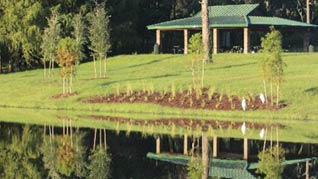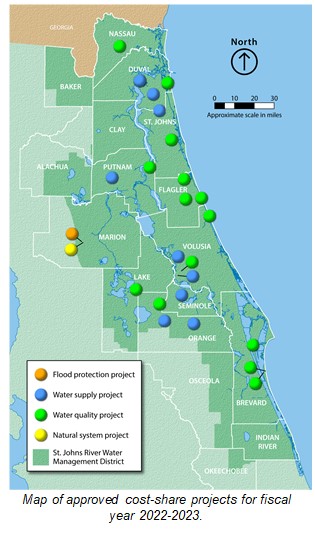District cost-share program will provide $20.5 million to support regional water resource protection efforts

Story revised as of Nov. 14, 2024 to update web links for Executive Order 19-12.

Pictured are previously funded projects, including (from left to right): Ocala Wetland Recharge Park, Osprey Acres Stormwater Park and Lake Lawne, a stormwater reuse project.
PALATKA, Fla., May 10, 2022 — The St. Johns River Water Management District Governing Board approved $20.5 million in funding for cost-share projects for fiscal year 2022–2023 as part of the Districtwide and Rural Economic Development Initiative (REDI) and Innovative cost-share programs. These projects all support one or more of the District’s core missions: water supply, water quality, flood protection and natural systems. Twenty-five projects were approved for funding, including 23 that directly support Gov. DeSantis’ Executive Order 19-12 “Achieving More Now for Florida’s Environment” that focuses, in part, on reducing the flow of nutrients to waterways and developing alternative water supplies.
“We appreciate the support of Gov. DeSantis, along with our Governing Board and the Florida Department of Environmental Protection, for their continued focus on providing funding for projects that benefit our shared water resources throughout the region,” says St. Johns River Water Management District Executive Director Mike Register. “These funding opportunities are helping local communities expand our reach to benefit and protect water resources.”
District cost-share funding for water resource protection and restoration projects helps local governments make progress in preserving, restoring and enhancing the Floridan aquifer system, which is where more than 90 percent of Florida’s drinking water comes from. Cost-share projects also benefit the St. Johns River, Indian River Lagoon and other waterways and Outstanding Florida Springs.
“Protecting and restoring water quality is a priority for not only the District, but also the state,” said St. Johns River Water Management District Chair Rob Bradley. “In addition to the District’s cost-share programs, historic funding has been provided by Gov. DeSantis and our state partners to encourage projects that reduce nutrient loading, conserve water and improve water quality.”
In total, 38 applications were ranked and scored based on District core mission benefits, cost effectiveness, likelihood of successful and timely completion, and application quality and completeness. Projects must begin during fiscal year 2022–2023 with completion expected within two years. The approved projects include:
- Thirteen water quality protection projects that are estimated to reduce the release of nutrients by 62,742 pounds of total nitrogen per year and 12,393 pounds of total phosphorus per year. These nutrients help fuel algal blooms, so reducing the amount entering waterbodies is the key to water quality restoration. Projects include:
- Palm Coast London Waterway Expansion which consists of constructing an 11-acre stormwater lake to improve water quality of the Pellicer Creek Aquatic Preserve.
- Brevard County Grand Canal Muck Removal Project (Phase IV), reducing nutrient loads to benefit the Banana River.
- Neptune Beach Wastewater Treatment Facility Process Upgrade, installation of upgraded equipment will reduce nutrient loads to the lower St. Johns River. Fewer nutrients in a water body mean less growth of algae which allows for healthy plants to have enough sunlight to grow.
- Nine water supply projects that include alternative water supply and water conservation projects were approved for funding. Maximizing the use of reclaimed water helps conserve traditional freshwater supplies and provides an environmentally responsible alternative to disposal of wastewater. Two of the reclaimed water projects are:
- Volusia County Southwest Regional Water Reclamation Facility, which includes the expansion of the facility and the construction of a 10-million-gallon reclaimed water storage tank to provide additional reclaimed water to the area.
- DeLand Reclaimed Water Main Extension (Phase 5) includes the installation of 4,700 linear feet (LF) of reclaimed water main and 13,500 LF of reclaimed water distribution main to serve the Cross Creek subdivision and community park.
- One approved project focused on the protection of natural systems and is estimated to increase flow at Silver Springs by 0.5 cubic feet per second.
- Ocala Lower Floridan Aquifer Conservation (phase 4)
- One flood protection project was approved and will provide 14 acres of flood protection for a local community in Marion County.
- Country Gardens Stormwater Remediation project includes the construction of a dry retention area and infrastructure for the stormwater conveyance system. Rerouting this stormwater away from the community protects homes from flooding during rain events.
The Board also approved sending a list of five springs restoration projects benefitting Outstanding Florida Springs, including Silver and Volusia Blue, to the Florida Department of Environmental Protection (DEP) for funding consideration, along with 11 alternative water supply projects also to be evaluated for DEP funding.
For information about District cost-share programs, visit www.sjrwmd.com/localgovernments/funding.
For a full list of projects, click here.


